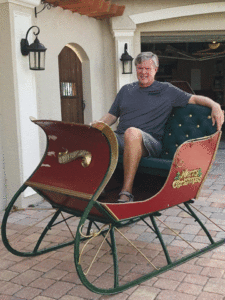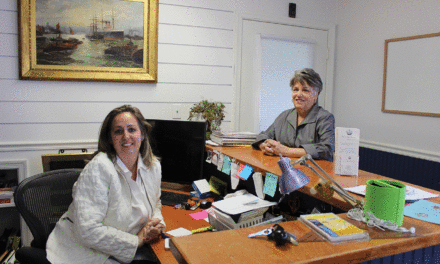
Ron Spering, who started his Christmas Past Sleigh Company in Chalfont, Pa., has always been handy and a big fan of everything relating to Christmas. Still, his second career restoring antique sleighs wasn’t planned. (Photo courtesy Ron Spering)
It’s been more than a century since the heyday of elegant sleighs dashing through the snow, their bell bedecked equines jingling all the way.
Yet in pictures and music and memories, they remain everlasting seasonal icons.
Some of these bygone treasures, such as Albany and Portland Cutters, Hudson Vis-à-vis, and brass bells enhanced with distinctive maker’s marks, though long neglected, are being rediscovered in barns, attics and sheds.
Not dissuaded by rusted bolts, rotten wood, peeling paint, grunge, and grime, a coterie of dedicated self-educated artisans has taken up the challenge of returning these diamonds in the rough to their former glory.
Seventy-five sleighs and counting
As a boy growing up in Southeast Missouri, there wasn’t usually much in the way of snow, 77-year-old Jack Bollinger, owner of Kringle Sleigh Company in Imperial, Mo., recalled.
But one winter, when the white stuff came down in droves, his minister created an indelible impression by arriving at church that Sunday in a sleigh.
A successful management professional 28 years ago, Bollinger sustained a brain stroke, leaving him wheelchair-bound with time and energy to spare.
Somehow, the memory of that childhood event resurfaced, inspiring him to try his hand at restoring a sleigh like the one he remembered.
The learning curve was high, but the satisfaction was great, and Bollinger searched auctions and online for more specimens to revive, eventually growing the hobby into a business.
To date, Bollinger has refurbished more than 75 antique sleighs, one more than 100 years old, for clients throughout the country, including the Ralph Lauren company.
The “pretty complicated” process of recreating some sleighs nearly from scratch sent him relentlessly researching the history of American sleigh production.
It also provided some impetus for innovating new ways to go at the problem.
He developed a painstaking method to create replacement curved runners in less time than the standard way of slowly steaming the wood to bend.
Instead, Bollinger slices a 1-inch plank of oak, ash or other hardwood a bit longer than the length of the original runner into 8 1/8-inch strips, glues them together, clamps at close intervals, beads a glue stream down the length of each strip and then spreads it across with a spatula.
He lets it dry overnight, loosens clamps, then planes 1/16 of an inch on each side.
After paint is applied, Bollinger believes it can pass muster as a solid original.
Caution must be paid to guard against toxic fumes when sanding the old parts, often containing sawdust mixed with lead, he warned.
Fresh air restoration pumps, masks, and hoods, which can run over $1,000, nevertheless are crucial, Bollinger believes.
A Portland Cutter, in disrepair after after 40 years of outside storage, currently awaits Bollinger’s reconstruction.
He said the Cutter reminds him of receiving a picture of a similar sleigh even more ramshackle, and a plea for help.
Appraising the photo, Bollinger replied that labor and material costs would likely be prohibitive.
But the man who sent the photo related how, as a youngster, his grandfather provided him rides in that particular sleigh.
While serving in Vietnam his grandfather passed and the sleigh was sold.
But in later years a good Samaritan delivered the remnants of the revered vehicle to him.
Without hesitation, Bollinger took on the job.
‘The craftsmanship can’t
really be duplicated’
Ron Spering, who started his Christmas Past Sleigh Company in Chalfont, Pa., has always been handy and a big fan of everything relating to Christmas.
He putters around in his workshop wearing holiday themed Hawaiian shirts, listening to carols while he works, all year round.
Still, his second career restoring antique sleighs wasn’t planned.
After selling his graphic arts company 10 years ago, with time to explore auctions near his 10-acre Bucks County, Pa. home, he happened upon a tumbledown sleigh.
With a leap of faith that he’d be able to learn how to restore it, Spering took it home and began.
Since then, Spering has “adopted” 110 rundown vintage sleighs, and the sideline became a successful company.
Because so many are over 100 years old, with metal fatigue and wood warped from being out in the elements far too long, his refinished sleighs are intended for décor rather than transport purposes.
Bronner’s CHRISTmas Wonderland of Frankenmuth, Mich., has been a client, and a commercial decorating company near his family’s relocated home on San Marco Island, Fla., bought two in one week recently.
“100 years ago the people building these didn’t have the tools or technology we have today,” he said, “but the craftsmanship can’t really be duplicated”.
He enjoys the privilege of seeing the original workmanship as well as learning how to repair and replace parts, striving to maintain the original design as much as possible.
To help his sleighs star in outdoor Christmas vistas during December, Spering reupholsters the inside with canvas fabric used for patio furniture, which can withstand the elements.
But he recommends that overall yard display time be limited.
With family still in Pennsylvania, Spering returns for periodic visits, traveling in a covered trailer to help transport any sleigh sightings during side trips to Lancaster and other local auction hotspots.
He’s managed to ship finished sleighs as far away as the western states of California and Washington.
Clean as a bell
DeeAnna Weed and Charles Kelly live and work in northeastern Iowa, along with Norwegian Fjord horses, dogs and cats, and occasionally, wildlife creatures seeking refuge.
Kelly wanted authentic antique sleigh bells for his horses.
What he managed to find provided a lovely sound but were sorely lacking in appearance.
Not knowing anyone who could safely clean the old bells, he decided to try his hand at it.
He next figured that others might also be in the market for the service his new-found skill would hopefully provide.
Kelly, an attorney, convinced wife DeeAnna Weed, an engineer, to lend her talents to the proposed venture, and Classic Bells was born.
Weed created a website to help spread the word, and while plenty of old bell owners responded, other challenges awaited.
First attempts at hand cleaning proved time consuming, labor intensive, and left dirt behind.
After several months experimenting, a successful method evolved.
First, the bells are soaked in a mild degreasing solution, next they are tumbled inside a device using porcelain beads and more solution to effectively remove remaining surface grime.
Then they are tumbled twice with a dry mixture of crushed walnut shell and polishing grit to get rid of oxidation, then a final finishing buff with just the walnut shell, produces a soft golden luster.
Weed soon became a student of 19th century horse straps, harnesses and related leatherwork, scouring every resource she could locate, then practicing hand stitching and rivet attachment techniques, even down to the detail of hand crafting from brass the figure-8 pins used to attach bells to straps. For authenticity she only uses copper belt and solid brass tubular rivets.
For more information, visit: kringlesleighcompany.com, christmaspastsleighco.com, and classicbells.com.





